Unveiling Aboriginal History: Western Australia’s Groundbreaking Online Database for Ancestral Tracing
In a landmark initiative, the Government of Western Australia has unveiled a groundbreaking online database that sheds light on a crucial chapter of Aboriginal history. This innovative resource chronicles the historical incarcerations of Aboriginal people on Wadjemup Island, also known as Rottnest Island, offering an unprecedented opportunity for ancestral tracing and historical understanding.

“Western Australia’s online database chronicles over 3,700 Aboriginal incarcerations on Wadjemup Island from 1838 to 1931.”
The Significance of the Wadjemup Island Database
We, as a society, are witnessing a pivotal moment in the acknowledgment and preservation of Aboriginal history. The Western Australia government’s initiative to create this comprehensive online database is a testament to the growing recognition of the importance of preserving and understanding our shared past.
Wadjemup Island, a place of immense cultural and historical significance for Aboriginal people, holds a dark chapter in Western Australia’s history. For nearly a century, until 1931, more than 4,000 Aboriginal men and boys were forcibly sent to this island, often for minor offenses or cultural practices that were deemed illegal under colonial laws.
- The database covers incarcerations from 1838 to 1931
- It includes records of over 3,700 Aboriginal individuals
- The resource aids in ancestral tracing for Aboriginal communities
- It contributes to a wider understanding of Aboriginal history in WA
This online database serves as a crucial resource for Aboriginal communities seeking to trace their ancestors and understand their family histories. It also provides valuable insights for researchers, historians, and the general public, offering a comprehensive look at this significant period in Western Australia’s past.
The Intersection of Technology and Cultural Heritage
The creation of this online database demonstrates the powerful intersection of technology and cultural heritage preservation. In an era where digital solutions are revolutionizing various aspects of our lives, it’s heartening to see technology being leveraged to address social issues and promote cultural understanding.
This initiative aligns with global efforts to use technology for social good, reminiscent of how companies like Farmonaut are utilizing advanced technologies to address challenges in agriculture and promote sustainability.
While Farmonaut focuses on agricultural technology, providing satellite-based farm management solutions, the principles of using technology to address societal challenges remain consistent across different sectors.
The Journey of Creating the Database
The development of this online database was no small feat. It required extensive research, digitization of historical records, and the creation of a user-friendly interface to make the information accessible to a wide audience. Let’s take a look at the timeline of events that led to this remarkable achievement:
| Year | Event/Development |
|---|---|
| Pre-1838 | Early Aboriginal history on Wadjemup Island |
| 1838 | Establishment of penal colony on Wadjemup Island |
| 1838-1931 | Period of Aboriginal incarcerations on the island |
| 1931 | End of Aboriginal incarcerations on Wadjemup Island |
| 2010s | Initiatives for historical documentation begin |
| 2020 | Development of the online database commences |
| 2023 | Launch of the Western Australia Aboriginal History Database |
| 2023-Present | Ongoing addition of records and refinement of the database |
This timeline illustrates the long journey from the dark days of Aboriginal incarcerations to the creation of a resource that now aids in healing and understanding. It’s a testament to the power of persistence and the importance of acknowledging our shared history.
The Impact on Aboriginal Communities
The launch of this online database has had a profound impact on Aboriginal communities across Western Australia. For many, it provides a long-awaited opportunity to connect with their ancestors and understand their family histories in greater detail.
- Facilitates ancestral tracing for Aboriginal families
- Provides closure for descendants of those incarcerated
- Offers educational resources for younger generations
- Contributes to the process of reconciliation and healing
By providing access to this historical information, the database is playing a crucial role in the ongoing process of reconciliation and healing within Aboriginal communities. It’s a powerful tool for education, enabling younger generations to learn about their history and cultural heritage.

The Broader Context: Technology and Social Issues
The creation of this database is part of a larger trend of using technology to address social issues and preserve cultural heritage. Around the world, we’re seeing innovative applications of technology in various fields, from agriculture to cultural preservation.
For instance, in the agricultural sector, companies like Farmonaut are leveraging satellite technology and AI to promote sustainable farming practices and improve food security. While the contexts differ, the underlying principle of using technology for social good remains consistent.
Similarly, in the realm of cultural preservation, we’re seeing numerous initiatives worldwide that use digital technologies to document, preserve, and share cultural heritage. These efforts are crucial in an increasingly globalized world where traditional cultures and histories are at risk of being lost.
Challenges and Opportunities in Digital Preservation
While the creation of this online database is a significant achievement, it also highlights some of the challenges and opportunities in digital preservation of historical and cultural information:
- Data accuracy and completeness
- Privacy concerns and sensitive information handling
- Accessibility for all community members
- Long-term maintenance and updates
- Integration with other historical resources
Addressing these challenges presents opportunities for further innovation and collaboration. It calls for ongoing dialogue between technologists, historians, community leaders, and policymakers to ensure that such resources remain valuable and respectful of the communities they serve.
“The Las Vegas Neon Museum expanded its collection by 30%, adding 60 new signs to its iconic boneyard.”
The Global Context: Similar Initiatives Worldwide
The Western Australian government’s initiative is part of a global movement towards acknowledging and preserving indigenous histories. Around the world, we’re seeing similar efforts to use technology in the service of cultural preservation and historical understanding:
- In Canada, the National Centre for Truth and Reconciliation maintains a database of residential school records
- The United States National Archives offers online access to Native American records
- New Zealand’s National Library provides digital access to Māori and Pacific cultural heritage materials
These initiatives demonstrate a growing global recognition of the importance of preserving and making accessible the histories of indigenous and marginalized communities. They also highlight the power of technology in bridging historical gaps and promoting cultural understanding.
The Role of Technology in Addressing Social Issues
The creation of this online database is a prime example of how technology can be leveraged to address social issues and promote advocacy. In an era where digital solutions are becoming increasingly prevalent, it’s crucial to consider how we can use these tools to tackle complex societal challenges.
From addressing historical injustices to promoting sustainable practices in agriculture, technology plays a pivotal role in driving positive change. Companies like Farmonaut, for instance, are using advanced technologies to promote sustainable farming practices and improve food security, demonstrating how innovation can address critical global challenges.
The Future of Historical Databases and Cultural Preservation
As we look to the future, the potential for further development and expansion of such historical databases is immense. We can anticipate several exciting possibilities:
- Integration of AI and machine learning for more efficient data analysis
- Virtual reality experiences that bring historical events to life
- Collaborative platforms allowing community members to contribute their own stories and memories
- Cross-referencing with other historical databases for a more comprehensive understanding
These advancements could revolutionize how we interact with historical information, making it more engaging, accessible, and relevant to contemporary audiences.
The Importance of Continued Support and Development
While the launch of this online database is a significant milestone, it’s crucial to recognize that this is an ongoing project that requires continued support and development. To ensure its long-term success and relevance, several factors need to be considered:
- Ongoing funding for maintenance and updates
- Regular consultations with Aboriginal communities to ensure respectful representation
- Continuous improvement of user interface and accessibility features
- Integration of new historical findings and research
- Development of educational programs to maximize the database’s impact
By addressing these aspects, we can ensure that this valuable resource continues to serve its purpose of preserving history, facilitating ancestral tracing, and promoting understanding for generations to come.
The Broader Impact on Historical Research and Education
The creation of this online database has implications that extend far beyond the Aboriginal communities it directly serves. It represents a significant advancement in historical research methodologies and educational resources:
- Provides researchers with unprecedented access to primary historical sources
- Offers educators new tools for teaching Australian history
- Encourages interdisciplinary approaches to historical study
- Promotes public engagement with history and cultural heritage
By making this wealth of historical information easily accessible, the database is helping to reshape our understanding of Australian history and promoting a more inclusive narrative that acknowledges the experiences of Aboriginal people.
The Role of Government in Preserving Cultural Heritage
The Western Australian government’s initiative in creating this database highlights the crucial role that governments can play in preserving cultural heritage and addressing historical injustices. It sets a precedent for other governments around the world to take similar actions in acknowledging and preserving the histories of indigenous and marginalized communities.
This project demonstrates how governments can:
- Allocate resources for cultural preservation initiatives
- Collaborate with indigenous communities in historical research
- Leverage technology for social good
- Promote reconciliation through acknowledgment of past injustices
- Support educational initiatives that promote cultural understanding
By taking these steps, governments can play a significant role in fostering social cohesion and promoting a more inclusive understanding of national history.
The Intersection of Technology and Social Responsibility
The development of this online database serves as a powerful example of how technology can be used responsibly to address social issues and promote cultural understanding. It highlights the importance of considering ethical implications and community impact when developing technological solutions.
This approach aligns with the principles of socially responsible technology, which emphasizes:
- Prioritizing user privacy and data security
- Ensuring accessibility for all users, including those with disabilities
- Considering the long-term societal impact of technological solutions
- Engaging with affected communities throughout the development process
- Using technology as a tool for empowerment and education
By adhering to these principles, technological initiatives like this database can make meaningful contributions to society while minimizing potential negative impacts.
The Future of Cultural Preservation in the Digital Age
As we look to the future, the Western Australian Aboriginal history database serves as a model for how cultural preservation can evolve in the digital age. It opens up exciting possibilities for similar initiatives around the world, potentially leading to a global network of interconnected cultural heritage databases.
Some potential future developments in this field could include:
- AI-powered translation tools to make cultural heritage accessible across language barriers
- Blockchain technology to ensure the authenticity and provenance of digital cultural artifacts
- Augmented reality applications that overlay historical information on real-world locations
- Crowd-sourced platforms for communities to contribute their own historical narratives
- Integration of DNA analysis tools to enhance ancestral tracing capabilities
These advancements could revolutionize how we preserve, study, and engage with cultural heritage, making it more accessible and relevant in our increasingly digital world.
Conclusion: A Step Towards Reconciliation and Understanding
The unveiling of Western Australia’s groundbreaking online database for Aboriginal ancestral tracing marks a significant milestone in the journey towards reconciliation and historical understanding. By leveraging technology to preserve and make accessible this crucial chapter of Aboriginal history, the initiative sets a powerful precedent for similar efforts worldwide.
As we’ve explored throughout this blog post, this database is more than just a historical record – it’s a tool for healing, a resource for education, and a testament to the power of technology when applied to address social issues. It demonstrates how innovation, when guided by ethical considerations and community needs, can play a crucial role in preserving cultural heritage and promoting social justice.
While there are challenges to overcome and opportunities for further development, the creation of this database represents a significant step forward. It offers hope for a future where technology and cultural preservation work hand in hand, fostering greater understanding and respect for the diverse histories that shape our world.
As we continue to navigate the complexities of our shared history, initiatives like this remind us of the importance of acknowledging the past, preserving cultural heritage, and using the tools at our disposal to build a more inclusive and understanding society. The journey towards reconciliation and historical justice is ongoing, but with each step, we move closer to a future where all histories are acknowledged, respected, and preserved for generations to come.
FAQ Section
Q: What is the purpose of the Western Australia Aboriginal History Database?
A: The database aims to chronicle historical incarcerations of Aboriginal people on Wadjemup Island, assist in ancestral tracing, and contribute to a wider understanding of Aboriginal history in Western Australia.
Q: How far back does the database go?
A: The database covers incarcerations from 1838 to 1931.
Q: Who can access this database?
A: The database is designed to be accessible to Aboriginal communities, researchers, historians, and the general public interested in this aspect of Western Australian history.
Q: How does this database contribute to reconciliation efforts?
A: By acknowledging this dark chapter in history and providing a resource for ancestral tracing, the database plays a crucial role in the ongoing process of reconciliation and healing within Aboriginal communities.
Q: Are there plans to expand the database in the future?
A: While specific plans aren’t mentioned, it’s likely that the database will continue to be updated and expanded as more historical records are digitized and new information becomes available.
Earn With Farmonaut: Affiliate Program
Earn 20% recurring commission with Farmonaut’s affiliate program by sharing your promo code and helping farmers save 10%. Onboard 10 Elite farmers monthly to earn a minimum of $148,000 annually—start now and grow your income!







